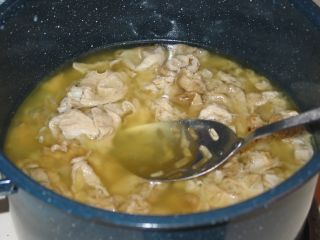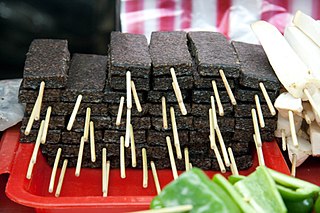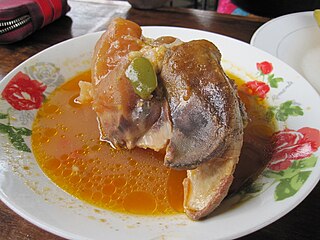
Tripe is a type of edible lining from the stomachs of various farm animals. Most tripe is from cattle, pigs and sheep.

Offal, also called variety meats, pluck or organ meats, is the internal organs of a butchered animal. The word does not refer to a particular list of edible organs, and these lists of organs vary with culture and region, but usually exclude skeletal muscle. Offal may also refer to the by-products of milled grains, such as corn or wheat.

Chitterlings, sometimes spelled chitlins or chittlins, are the large intestines of domestic animals. They are usually made from pigs' intestines. They may also be filled with a forcemeat to make sausage. Intestine from other animals, such as cow, lamb, goose, and goat is also used for making chitterling.
Jamaican cuisine includes a mixture of cooking techniques, flavours and spices influenced by Amerindian, West African, Irish, English, French, Portuguese, Spanish, Indian, Chinese and Middle Eastern people who have inhabited the island. It is also influenced by the crops introduced into the island from tropical Southeast Asia, many of which are now grown locally. A wide variety of seafood, tropical fruits and meats are available.

The wild goat is a wild goat species, inhabiting forests, shrublands and rocky areas ranging from Turkey and the Caucasus in the west to Turkmenistan, Afghanistan and Pakistan in the east. It has been listed as near threatened on the IUCN Red List and is threatened by destruction and degradation of habitat.

Cameroonian cuisine is one of the most varied in Africa due to Cameroon's location on the crossroads between the north, west, and center of the continent; the diversity in ethnicity with mixture ranging from Bantus, Semi-bantus and Shuwa Arabs, as well as the influence of German, French and English colonialization.

Blood as food is the usage of blood in food, religiously and culturally. Many cultures consume blood, often in combination with meat. The blood may be in the form of blood sausage, as a thickener for sauces, a cured salted form for times of food scarcity, or in a blood soup. This is a product from domesticated animals, obtained at a place and time where the blood can run into a container and be swiftly consumed or processed. In many cultures, the animal is slaughtered. In some cultures, blood is a taboo food.

Goat meat or goat's meat is the meat of the domestic goat. The common name for goat meat is simply "goat", while that from young goats can be called "kid", capretto (Italian), or cabrito. In South Asian and Caribbean cuisine, mutton commonly means goat meat. In South Asia, where mutton curry is popular, "mutton" is used for both goat and lamb meat.

Javanese cuisine is the cuisine of Javanese people, a major ethnic group in Indonesia, more precisely the province of Central Java, Yogyakarta and East Java.

Padang dish or Minangkabau dish is the cuisine of the Minangkabau people of West Sumatra, Indonesia. It is among the most popular cuisines in Maritime Southeast Asia. It is known across Indonesia as Masakan Padang after Padang, the capital city of Western Sumatra province. It is served in restaurants mostly owned by perantauan (migrating) Minangkabau people in Indonesian cities. Padang food is ubiquitous in Indonesian cities and is popular in neighboring Malaysia and Singapore.
Cow cod soup is a traditional, rustic dish in Jamaican cuisine that is considered an aphrodisiac and made with bull penis. It is traditionally cooked with bananas and Scotch bonnet peppers in a white rum-based broth. Cow cod is a rural delicacy.

Sundanese cuisine is the cuisine of the Sundanese people of Western Java, and Banten, Indonesia. It is one of the most popular foods in Indonesia. Sundanese food is characterised by its freshness; the famous lalab eaten with sambal and also karedok demonstrate the Sundanese fondness for fresh raw vegetables. Unlike the rich and spicy taste, infused with coconut milk and curry of Minangkabau cuisine, the Sundanese cuisine displays the simple and clear taste; ranged from savoury salty, fresh sourness, mild sweetness, to hot and spicy.

Omani cuisine is part of the Khaleeji cuisine and is influenced by Arab, Pakistani cuisine, Iranian, Indian, Asian, Eastern Mediterranean, and African cuisine, reflecting Oman's position as a vast trading empire at the intersection of traditional spice trade routes. Dishes are often based on chicken, fish, and lamb, as well as the staple of rice. Most Omani dishes tend to contain a rich mixture of spices, herbs, and marinades. Omani cuisine differs from other cuisines in the Arabian peninsula, as it is less spicy and seldom served warm.

Tongseng is an Indonesian goat meat, mutton or beef stew dish in curry-like soup, with vegetables and kecap manis. Tongseng is commonly found in the Indonesian region of Central Java; from Surakarta to Yogyakarta. However, it is believed that the dish originated from Klego district in Boyolali, Central Java.

Betawi cuisine is rich, diverse and eclectic, in part because the Betawi people that create them were composed from numbers of regional immigrants that came from various places in the Indonesian archipelago, as well as Chinese, Indian, Arab, and European traders, visitors and immigrants that were attracted to the port city of Batavia since centuries ago.

Cow's trotters are the feet of cattle. The cuts are used in various dishes around the world, especially in Asian, African, French, and the Caribbean cuisine. Latin American cuisine also uses cow's trotters for several traditional dishes.














